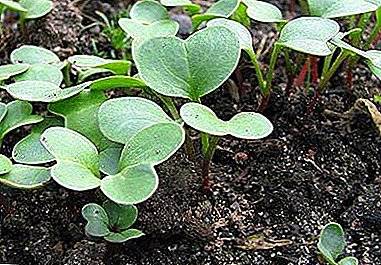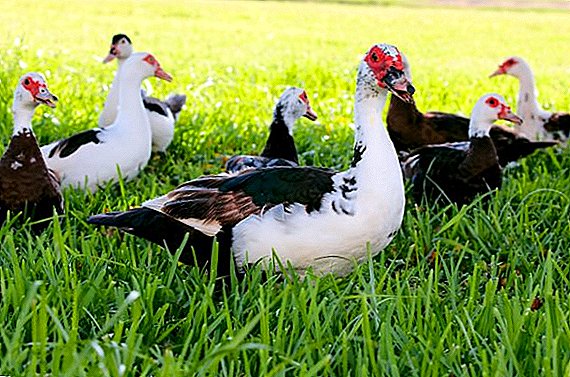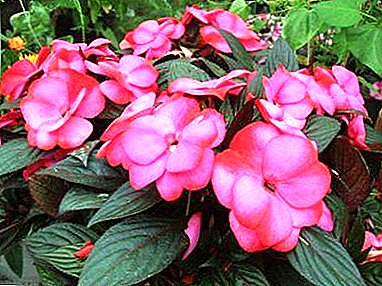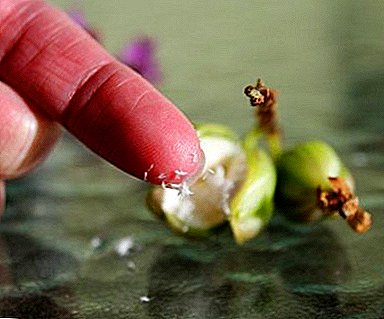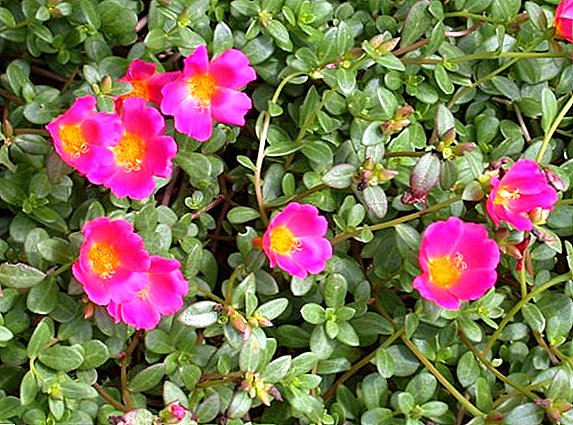 Often in the gardens you can find patches of land, completely covered with bright multi-colored flowers, as if covered with a colorful carpet. These plants are called by the people - "mats". The scientific name of this flower is Portulaca (portulaca). His homeland - the tropical regions of the northern hemisphere. It is a creeping perennial, although it is grown here one year because it is not adapted to the conditions of our winters.
Often in the gardens you can find patches of land, completely covered with bright multi-colored flowers, as if covered with a colorful carpet. These plants are called by the people - "mats". The scientific name of this flower is Portulaca (portulaca). His homeland - the tropical regions of the northern hemisphere. It is a creeping perennial, although it is grown here one year because it is not adapted to the conditions of our winters.
Did you know? The name of the plant comes from the Latin word "portula", which translates as a small gate. The flower was so named because its seed box in an open form resembles an open gate.
In the wild, purslane is widespread and includes about 200 species. Only two of its varieties are represented in culture: the large-flowered purslane and the garden purslane, each of which includes several varieties.
Portulaca grandiflora (Portulaca grandiflora)
The plant reaches a height of 30 cm. Its leaves are small, fleshy, cylindrical, green or slightly reddish. Stems creeping. The flowers are average, with a diameter of 2.5-3 cm, have the shape of a cup of five petals fused together. There are simple and terry, various colors: red, white, cream, orange, yellow, pink. Portulac flowering period is from June to October.
Did you know? Flowers live just one day, but the flowering in the bush is so lush that it creates an illusion, as if they are continuously blooming.
 This type is used in ornamental gardening. A portulac covering both soil and slopes. It is used on stone walls, rockeries, on the slopes of alpine hills, in mixborders (in the foreground), as a curb plant. On dry soils, lawns are made of it. Also planted in hanging pots and boxes on the balconies, loggias.
This type is used in ornamental gardening. A portulac covering both soil and slopes. It is used on stone walls, rockeries, on the slopes of alpine hills, in mixborders (in the foreground), as a curb plant. On dry soils, lawns are made of it. Also planted in hanging pots and boxes on the balconies, loggias.
For exquisite gardeners displayed several varieties of portulaca grandiflora. We describe the most common.
Scarlet
The plant of this variety is one of the lowest, the height of its stems does not exceed 10-12 cm. It has a strongly branched stem. Leaves - small, fleshy, cylindrical. Flowers - terry, bright scarlet color, with a diameter of 5 cm. It blooms from early June to frost. Flowers open only in sunny weather.
Important! Portulak scarlet is thermophilic, drought-resistant and very light-requiring. Even with a slight darkening stops throwing flowers. Loves dry sandy and sandy soils.
Apply scarlet purslane for planting in vases, balcony boxes, between the plates of garden paths. Used for decorating the southern slopes.
Belotsvetkovy
 This variety is attractive due to large white terry inflorescences that look like marshmallows. It grows quickly and grows - in a short time its bush can reach 35-40 cm in diameter. Resistant to heat and drought. Able to grow and bloom even in stony soil without additional dressing.
This variety is attractive due to large white terry inflorescences that look like marshmallows. It grows quickly and grows - in a short time its bush can reach 35-40 cm in diameter. Resistant to heat and drought. Able to grow and bloom even in stony soil without additional dressing.
In landscape gardening culture used for decoration of rocky hills, borders, planted in pots and containers.
"Pun"
 Due to the fact that the purslane variety "Kalambur" is widely spread, it is an excellent ground cover plant. Blooms luxuriantly with double and semi-double flowers of various bright colors with a diameter of 4 cm. Requires a sunny location. It prefers drained, light, sandy soils, but survives even in very poor soils. Drought resistant
Due to the fact that the purslane variety "Kalambur" is widely spread, it is an excellent ground cover plant. Blooms luxuriantly with double and semi-double flowers of various bright colors with a diameter of 4 cm. Requires a sunny location. It prefers drained, light, sandy soils, but survives even in very poor soils. Drought resistant
Suitable for creating flower beds. It is used in the design of alpine slides and borders.
Orange
The purslane orange has a strongly branched stem. It grows up to 10-12 cm in height. The flowers are bright orange in color with a diameter of 5 cm. The buds open only on sunny days. This species is planted in dry sand and sandy soil. He is drought-resistant, frequent watering him to anything. Does not tolerate low temperatures and shade.
 In landscape design is used in flower beds and stony hills. Planted in flowerpots, containers on balconies, loggias, window openings. It is possible to plant in pots as an ampelous plant.
In landscape design is used in flower beds and stony hills. Planted in flowerpots, containers on balconies, loggias, window openings. It is possible to plant in pots as an ampelous plant.
"Sanglo"
The main feature of the "Sanglo" is that its flowers, unlike most other varieties, do not close in cloudy weather. In addition, it gives the largest flowers - up to 6 cm in diameter. Inflorescences can be a variety of colors: white, scarlet, gold, orange, pink, peach.
 Like most portulakovy, it is a light and heat-loving plant with high resistance to heat and drought and undemanding to the composition of the soil.
Like most portulakovy, it is a light and heat-loving plant with high resistance to heat and drought and undemanding to the composition of the soil.
Looks good in carpet flower beds, when decorating borders.
"Sonya"
Portulaca "Sonya" refers to plants that can grow on very poor soils. It grows well in the open sun in areas with loose sandy soil. This mixture produces bright multicolored flowers that bloom profusely and for a long time.
This purslane is recommended as an element of the design of alpine slides, rocky gardens, decorating the southern slopes.
"Splendex"
 "Splendex" attracts attention with its large flowers of bright pink or purple-pink flowers. It is a free-flowering creeping undersized plant with a height of 10 cm. The stems are light green with a reddish tinge. The structure of the flowers can be simple or terry. In diameter, they reach 3-4 cm.
"Splendex" attracts attention with its large flowers of bright pink or purple-pink flowers. It is a free-flowering creeping undersized plant with a height of 10 cm. The stems are light green with a reddish tinge. The structure of the flowers can be simple or terry. In diameter, they reach 3-4 cm.
This view is perfect for creating carpet compositions and group plantings on lawns, for the front background of rockeries and alpine slides. Splendex can also be decorated with balconies.
Cherry
Undersized variety with highly branched stems up to 12 cm. The flowers in "Cherry" terry, cherry color, hence the name. Like most varieties of portulaca, Cherry likes light and warmth. Easily adapts to a cool, damp climate. It tolerates hot and dry weather. Blooms luxuriantly, from June until frost. Requires rare and non-abundant watering.
 Apply to decorate the southern slopes of the site, when making borders, stony hills, in flower beds. Planted in vases and containers.
Apply to decorate the southern slopes of the site, when making borders, stony hills, in flower beds. Planted in vases and containers.
"Flamenco"
Flamenco - terry purslane up to 20 cm high with multicolored flowers and a strong root system. The flowers are double, with a diameter of 4-6 cm, of various shades. Feels good in dry, sandy and stony soil. Heavy and acid soils do not suit him. Poor blooms on rich fertile soils and in cloudy weather. It can live for a long time without irrigation, it is watered only with a strong drought.
Portulaca "Flamenco" planted on the southern slopes of flower beds and rocky hills.
Portulaca garden (Portulaca oleracea)
In addition to decorative, there is garden or edible (vegetable) purslane. Sometimes it is also called "dandur". This is an annual plant up to 40 cm in height with oval succulent leaves and small yellow flowers with a diameter of 7-8 mm. It blooms from June to September.
 Due to the fact that this type of portulaca can grow on almost any soil, it is often considered a weed. Although this dandur has healing and good taste properties. In cooking, there are many recipes for dishes, one of the ingredients of which is purslane. From its leaves and stems, you can cook soups, salads, pickle, add as a seasoning in vegetable dishes, gravy and sauces.
Due to the fact that this type of portulaca can grow on almost any soil, it is often considered a weed. Although this dandur has healing and good taste properties. In cooking, there are many recipes for dishes, one of the ingredients of which is purslane. From its leaves and stems, you can cook soups, salads, pickle, add as a seasoning in vegetable dishes, gravy and sauces.
Did you know? Vegetable purslane contains vitamins A, B, E, PP, K, carbohydrates, proteins, carotene, ascorbic and nicotinic acids, magnesium, potassium, calcium, zinc, iron, manganese.
Purslane is an excellent antioxidant and diuretic. It is added to medicinal extracts in the treatment of diseases of the kidneys and liver, for insomnia. It is believed that it affects the normalization of blood pressure and blood sugar levels.
Garden purslane also includes several varieties.
"Kuzminsky Semko"
This variety can be found on the green with a yellowish tinge of leaves and small yellow flowers. The plant is very thermophilic, so much so that it ceases to grow at low positive temperatures, and at insignificant frosts it dies.
"Macovei"
 A strong leaf plant with a stem height of 30-35 cm. Its leaves are smooth, glossy, crunchy. The yield of green - 1.5 kg / sq. m Thermally. Unpretentious to the soil. The leaves and the tops of the stems are used for making salads and for canning.
A strong leaf plant with a stem height of 30-35 cm. Its leaves are smooth, glossy, crunchy. The yield of green - 1.5 kg / sq. m Thermally. Unpretentious to the soil. The leaves and the tops of the stems are used for making salads and for canning.
Important! For therapeutic purposes, it is recommended as a wound-healing agent and as a component of tinctures in diabetes, kidney and liver diseases.
"Paradox"
Portulaca "Paradox" loves light, heat, does not tolerate negative temperatures. Valuable fleshy and thick leaves of green and green-pink color. The variety is early ripening - the period from germination to ripeness is only 25-30 days. In cooking, he is advised as an alternative to spinach. From the greens of "Paradox" they prepare multivitamin salads, cook soups, use them in sauces and as a seasoning for meat dishes, it is pickled and marinated.
"Glowworm"
 A portulak garden "Firefly" gives juicy, fleshy stems and leaves. It grows in height to 45-50 cm. This purslane loves sunny, shaded areas, fertile and moist soil. With one square meter you can collect 2.5 kg of leaves and shoots for later use in food. Greens have a sour taste.
A portulak garden "Firefly" gives juicy, fleshy stems and leaves. It grows in height to 45-50 cm. This purslane loves sunny, shaded areas, fertile and moist soil. With one square meter you can collect 2.5 kg of leaves and shoots for later use in food. Greens have a sour taste.
"Firefly" is advised to eat people who suffer from diabetes, kidney and liver disease.
For summer residents, purslane is interesting, first of all, because of its unpretentiousness. When planting, it is necessary to take into account that this plant is light and heat-loving, therefore, it is necessary to choose a bright place for it. The optimum temperature is + 20-26 Cº. Although the flower easily tolerates a slight decrease in degrees. Sole purslane loves sandy, without peat.
Also requires regular watering, weeding and thinning. Provided that all these factors are observed, excellent floral “rugs” will come out that will delight you throughout the summer.


